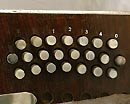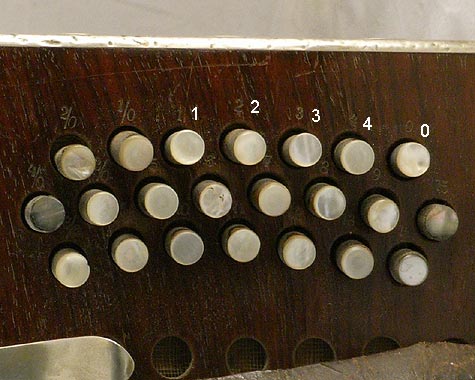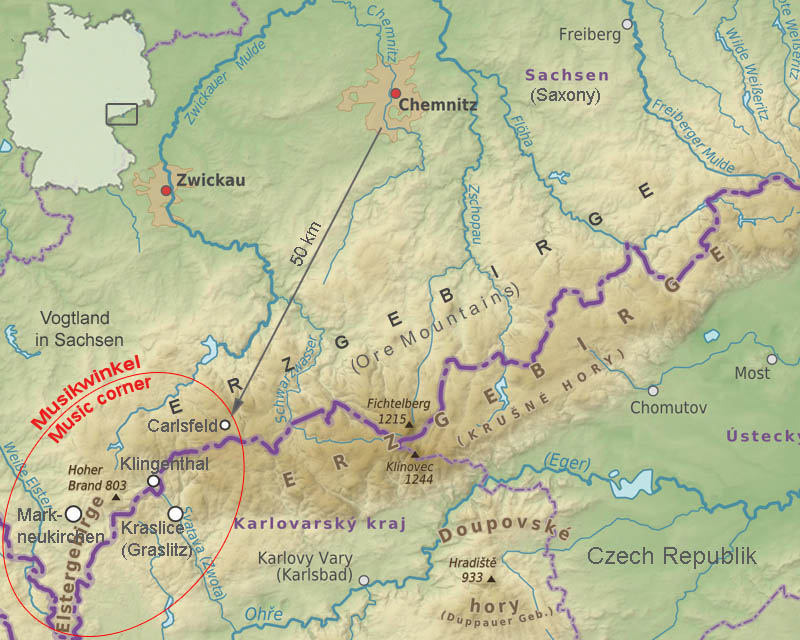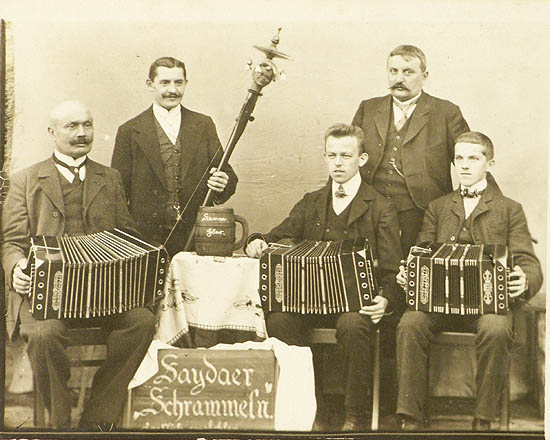
Deutsche Konzertina
Chemnitzer System, 76 tones
bisonoric
(Collection Oriwohl, Nr. A-87)
Manufacture: presumably Co. Wilhelm Dölling (founded 1898, Klingenthal) around 1900
Zinc plates with steel tongues, (H: 20,5cm D: 20,5cm)
Range: G - e3, 2-choirs
Another instrument of the 76-tones concertina, which was widely used at the time, whose bellows flap plate (sheet metal decoration in front of the air flap) contains a D in the middle. This could refer to the Dölling company in Klingenhtal in the Musikwinkel (Music Corner).


Left side: G - h1
With the first concertinas, each tone was only present once (pull or push), which limited playability. With every larger model, therefore, not only the range was extended, but many tones made available for both bellows directions by additional reeds.
The main reason for the bisonoric principle, many tones in the smallest of spaces while saving expensive reeds, is becoming obsolete due to the growing needs of musicians.


Right side: e1 - e3
Although 19 out of 23 tones (83%) of the right side are available for push and pull, these are not placed on one key as an unisonoric system, but remain in consideration of the learnded repertoire of the musicians and the already widespread distributed learning and playing literature.
The introduction of a fundamentally new system, such as, for example, from 1839 onwards the Boehm flap system for the clarinet, which also required the clarinettists to retrain, did not take place in concertina construction.


Left manual:
Range G - a1, 2-choir (8'+4' of which 4 basic tones
G, D, A, E as 16'+8')
With the steadily growing tone stock, the once diatonic, instruments, which were only designed for a few scales, are becoming more and more chromatic.
Here the chromatic range already goes from f# to a1. On the right manual from f#1 to e3.


Right manual:
Range e1 - e3, 2-choir (8'+4')
The (inserted) numbering '1,2,3,4,0' shows the Chemnitz keyboard system recognisable.


After Uhlig's invention of the Deutsche Konzertina in the industrial city of Chemnitz, other instrument makers soon began to produce concertinas. In the nearby Mountains Erzgebirge, Carl Friedrich Zimmermann in Carlsfeld was the first to follow Uhlig's example.
However, the Vogtland region west of Carlsfeld already had a long tradition in the construction of violins and brass instruments. But free reeds have also been used in mouth harmonica making for a long time. Accordions based on Demian's model were also made.
It is not for nothing that places such as Markneukirchen, Adorf, Bad Brambach, Klingenthal and the Bohemian Graslitz (Kraslice) and Schönbach (Luby) were called as Musikwinkel (Music corner). The Dölling company in Klingenthal was also part of this handicraft tradition.
In the 1930s, Ernst Louis Arnold (E.L.A.) and his son Alfred (AA) made the Musikwinkel even more internationally known with bandonions from Carlsfeld.


The Musikwinkel is located on the western edge of the Erzgebirge. About 30 km to the east of it is the 1244 m high Klinovec, the peak of the mountains. The small border village Gottesgab (Boží Dar) at the foot of which, was the home of the famous dialect singer and poet Anton Günter (1876-1937). His songs are true hymns of the Erzgebirg people:
Wu de Wälder hamlich rauschn...
Where the forests rustle at home,
where the heather blooms so reddish,
I don't want to trade places with any king,
'cause there my little house is standing up there.
On the stove bench in an Erzgebirg sitting room in the middle of the 20th century with local instrumentation: guitars and Konzertina.
Ski and toboggan good, although unfortunately less often:
♫ Heinerle's Winterlied, Erzgebirgs-Ensemble 1974, Singing and Konzertina.


The ridge of the Erzgebirge stretches for about 120 kilometres. In the Osterzgebirge, the eastern part, lies the small town of Sayda, about 10 kilometers from the Bohemian border.
The gentlemen of the Saydaer "Schrammeln" cultivated hearty Schrammelmusik according to the Viennese model. However, probably in the absence of an original Schrammel double guitar, a devil's violin was engaged as bass and rhythm accompaniment.


"Feierabend vor der Schmiede" (Quitting time in front of the forge) (Photo H. Krausse, Steinbach/Erzg.,
Art Publishers Wilhelm Vogel, Schwarzenberg i.Sa., coloured postcard)
The generations under one roof. Woman and child making bobbin lace (a kind of crocheting with round woods - the bobbin), a formerly widespread home craft in the Erzgebirge.
The Erzgebirge (Ore Mountains), as the name suggests, were settled as a result of ore mining. With industrialisation and railway connections in the 19th century, a diverse processing industry also developed, such as textile production or instrument making. Nevertheless, the Erzgebirge were considered rather a poor region, whose inhabitants had to go through difficult times during economic crises.
